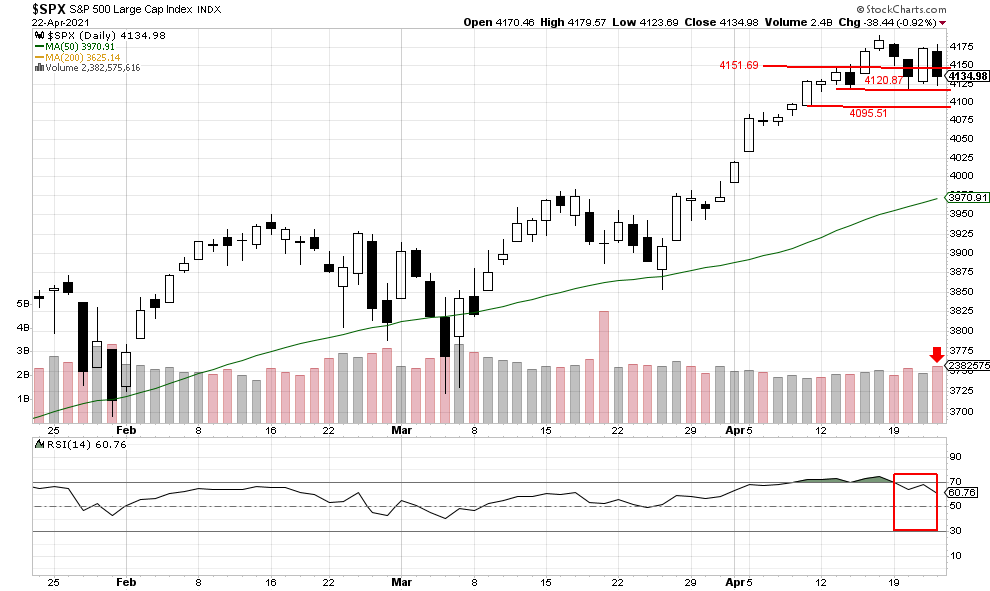Morning Commentary

Headline News:
U.S. stock futures are higher despite the announcement of President Biden’s proposed capital gain increase sent that markets lower on Thursday. The plan would almost double the tax on the wealthiest taxpayers and included the most extensive levies on investment gains. Meanwhile, later today, economic reports on manufacturing and services PM and New Home Sales will be released. Investors will continue to watch these reports along with more Q1 earnings reports.
Markets:
The S&P 500 traded in a wide range on Thursday and tested for, a second time, support at 4120.87 and held. The index had earlier moved past resistance at 4151.69 only to close lower at 4134.98. There was a pick-up in volume with 2,382,575,616 shares traded, and RSI continued to move lower, closing at 60.76. The selling was in reaction to a potential increase in the capital gains tax for higher-income taxpayers. So, the trading today could indicate if the sellers are truly back in charge. We still feel a test of potential support at 4095.51 will happen soon.
We are currently long-term bullish and short-term cautious.

John N. Lilly III CPFA
Accredited Portfolio Management Advisor℠
Accredited Asset Management Specialist℠
Portfolio Manager, RJFS
Partner, DJWMG
Windsor Wealth Planners & Strategist
Futures trading is speculative, leveraged, and involves substantial risks. Investing always involves risk, including the loss of principal, and futures trading could present additional risk based on underlying commodities investments.
The Relative Strength Index (RSI), developed by J. Welles Wilder, is a momentum oscillator that measures the speed and changes of price movements.
The S&P 500 is an unmanaged index of 500 widely held stocks that is generally considered representative of the U.S stock market. Past performance may not be indicative of future results. Keep in mind that individuals cannot invest directly in any index, and index performance does not include transaction costs or other fees, which will affect actual investment performance. Individual investors’ results will vary. Opinions expressed are those of the author John N. Lilly III, and not necessarily those of Raymond James. “There is no guarantee that these statements, opinions, or forecast provided herein will prove to be correct. “The information contained was received from sources believed to be reliable, but accuracy is not guaranteed. Investing always involves risk, and you may incur a profit or loss. No investment strategy can guarantee success. The charts and/or tables presented herein are for illustrative purposes only and should not be considered as the sole basis for your investment decision. International investing involves special risks, including currency fluctuations, different financial accounting standards, and possible political and economic volatility. Investing in emerging markets can be riskier than investing in well-established foreign markets.
This is not a recommendation to buy or sell any company’s stock mentioned above.
US government bonds and treasury bills are guaranteed by the US government and, if held to maturity, offer a fixed rate of return and guaranteed principal value. US government bonds are issued and guaranteed as to the timely payment of principal and interest by the federal government. Bond prices and yields are subject to change based upon market conditions and availability. If bonds are sold prior to maturity, you may receive more or less than your initial investment. Holding bonds to term allows redemption at par value. There is an inverse relationship between interest rate movements and bond prices. Generally, when interest rates rise, bond prices fall and when interest rates fall, bond prices generally rise.



